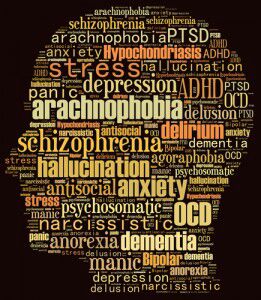What Is Dementia?
Dementia is a general term for loss of memory, language, problem-solving and other thinking abilities that are severe enough to interfere with daily life. Alzheimer’s is the most common cause of dementia.
About dementia

Dementia is not a single disease; it’s an overall term — like heart disease — that covers a wide range of specific medical conditions, including Alzheimer’s disease. Disorders grouped under the general term “dementia” are caused by abnormal brain changes. These changes trigger a decline in thinking skills, also known as cognitive abilities, severe enough to impair daily life and independent function. They also affect behavior, feelings and relationships.
Alzheimer’s disease accounts for 60-80% of cases. Vascular dementia, which occurs because of microscopic bleeding and blood vessel blockage in the brain, is the second most common cause of dementia. Those who experience the brain changes of multiple types of dementia simultaneously have mixed dementia. There are many other conditions that can cause symptoms of dementia, including some that are reversible, such as thyroid problems and vitamin deficiencies.
Dementia is often incorrectly referred to as “senility” or “senile dementia,” which reflects the formerly widespread but incorrect belief that serious mental decline is a normal part of aging.
Learn more: Common Types of Dementia, What is Alzheimer’s?
Causes of Dementia
Dementia comes from damaged nerve cells in the brain. Individuals with dementia are affected differently, depending which part of the brain is damaged. Damaged brain cells cannot communicate with other brain cells normally, affecting thinking, behavior, feelings, memory, and movement.
But what causes dementia?
Neurodegenerative Causes of Dementia
Neurodegeneration is the leading biological cause of dementia, and often leads to Alzheimer’s disease. Neurodegeneration breaks down and kills brain cells (neurons). Over time, dying brain cells cause a permanent and progressive decrease in mental and physical function. Types of dementia that result from neurodegeneration include the following:
Alzheimer’s Disease (AD)
Dementia with Lewy Bodies (DLB)
Frontotemporal Dementias (FTD)
Parkinson’s Disease Dementia (PD)
Huntington’s Disease (HD)
Cerebrovascular Causes of Dementia
Usually the result of strokes, heart disease, and/or hardening of the blood vessels supplying the brain (atherosclerosis), cerebrovascular damage from hemorrhaging, malformation, or blockage is a common biological cause of dementia. Localized areas of the brain are destroyed (so-called “infarcts”) from lack of blood supply (oxygen). The type of dementia that results from cerebrovascular disease is as follows:
Vascular or Multi-Infarct Dementia (VD)
 Infection-Related Dementia
Infection-Related Dementia
Infections also cause dementia. Viruses, bacteria, and parasites can destroy brain cells and dementia can result—usually in the later stages of severe infections. Common types of dementia caused by infection include the following:
Creutzfeldt-Jackob Disease (CJD) and other Prion Diseases
Dementia associated with HIV/AIDS
Toxic and Metabolic Causes of Dementia
Dementia can also result from a chemical imbalance in the body caused by a toxin (e.g. drugs), malnutrition, or other biological conditions, such as metabolic disorders. This form of dementia includes the following:
Wernicke-Korsakoff Syndrome (WKS)
Leukodystrophy
Traumatic Causes of Dementia
Serious injuries and concussions to the head and brain are another cause of dementia. This category includes the following dementia:
Traumatic Brain Injury (TBI)
Type of Respite Care
Respite care is temporary care (a few hours, a day, a few days, or even a couple weeks) for loved ones with dementia that allow caregivers a needed break from caregiving duties. This break allow caregivers time for self-care, errands, and spending time with other people, without having to worry about your loved one with dementia.
A friend / family member can informally provide this type of care in the home or an in-home care provider is able to provide respite care. It can also be provided in a facility, such as adult day care facility or a nursing home. Depending on the type of respite care, the cost varies from free to rather costly.
In-Home Respite Care
 In-home respite care, sometimes called in-home assistance or companionship, is a service where someone from outside the home comes to your home to watch and care for your loved one in your absence. Additionally, these companion aides, personal care assistants, and home health aids, are often available to help with minor household chores, such as laundry and meal preparation. They can also assist your loved one with activities of daily living (ADLs), such as bathing, dressing, and eating. Many caregivers use this form of respite care as a way to have a couple of hours to themselves to run a few errands or to relax. In addition, live-in caregivers can also provide in-home respite care, allowing family caregivers to take a vacation or simply have some downtime for a few days to prevent caregiver burnout. Formally, professional aides and home health aides, who are available through government or community agencies, provide in-home respite care. Informally, respite care can be provided by a friend or family member who agrees to care for your loved one while you take a break from caregiving duties.
In-home respite care, sometimes called in-home assistance or companionship, is a service where someone from outside the home comes to your home to watch and care for your loved one in your absence. Additionally, these companion aides, personal care assistants, and home health aids, are often available to help with minor household chores, such as laundry and meal preparation. They can also assist your loved one with activities of daily living (ADLs), such as bathing, dressing, and eating. Many caregivers use this form of respite care as a way to have a couple of hours to themselves to run a few errands or to relax. In addition, live-in caregivers can also provide in-home respite care, allowing family caregivers to take a vacation or simply have some downtime for a few days to prevent caregiver burnout. Formally, professional aides and home health aides, who are available through government or community agencies, provide in-home respite care. Informally, respite care can be provided by a friend or family member who agrees to care for your loved one while you take a break from caregiving duties.
Whether a professional or family friend, make sure that the person providing care has a good understanding of Alzheimer’s Disease and dementia. You should also let your respite caregiver know what to expect from your loved one in terms of their likes and dislikes and their strengths and weaknesses. Some caregivers find it helpful to prepare a few activities beforehand, such as looking through photos or listening to music. These activities can provide structure and make the time spent together go more smoothly for your loved one and their companion.
Adult Day Respite Care
Adult day care offers daytime supervision for elderly frail adults, as well as persons with dementia. Care can be provided anywhere from a few hours during the day to the entire day. Meals, snacks, activities, supervision, and personal care assistance is provided. Some adult day care centers even offer transportation to and from the adult day care facility. Adult day care is a great care option for caregivers who work part or full-time or simply need some downtime. However, it’s important that you choose an adult day care facility that understands the needs of persons with dementia.
Residential Respite Care
Whereas in-home services can provide respite care for a few hours a day or a couple of days, residential respite care, sometimes called short-term assisted living, is an option that can provides professional care for a longer period of time. For instance, residential respite care can be provided for as long as a couple of weeks. This kind of overnight respite care often takes place in dedicated units in hospitals or nursing homes, but there are also boarding houses in some areas that offer temporary services. Residential respite care can be an important service for families who are finding themselves stressed or burdened and need to take an extended break or vacation.
Remember that new places and routines can be distressing for persons with Alzheimer’s disease or dementia. If you do choose to use overnight respite care, be sure that the facility appreciates your loved one’s needs and that your loved one has some familiar items with him or her during the stay.
Prevent of Alzheimer’s & Other Dementias
There is no known way to prevent Alzheimer’s disease and other related dementias. However, there are actions that one can take to reduce the risk for dementia and, in some cases, slow the progression of the disease. These factors include:
- Physical Exercise
- Healthy Diet
- Heart Healthy Behaviors
- Avoiding Head Injury
- Mental Activities
- Socializing
Some factors may decrease the effect of brain damage due to dementia by developing more connections between the remaining brain cells, rather than preventing damage. With more connections between brain cells, function can be maintained longer despite damage to the brain.
Healthy Diet
There is a connection between eating a heart healthy diet and having a healthy brain. A healthy diet that includes fruit, vegetables, nuts, whole grains, poultry, fish, and legumes may reduce the risk of developing dementia. In addition, red meat, sugar, and saturated fats should be limited in one’s diet. The Mediterranean diet is marked by a high intake of olive oil, fruits and vegetables, whole grains, and fish and poultry, and is associated with a lower risk of developing Alzheimer’s and Parkinson’s disease (Scarmeas et al, 2009). Another diet, Dietary Approaches to Stop Hypertension (DASH), may also be beneficial in preventing dementia, and emphasizes a diet high in fruits, vegetables, and dairy foods that are low in fat. A fair amount of whole grains, nuts, poultry, and fish is also encouraged.
There is limited evidence that a diet high in fruits and vegetables protects brain neurons (cells) from chemicals, called free radicals, which damage cells. The protective chemicals in these foods are called antioxidants. Other foods that may protect against dementia include curcumin, the main ingredient in the spice turmeric, and omega-3 fatty acids, found in fish.
Physical Exercise
Regular physical exercise leads to a healthier brain by increasing the flow of oxygen and blood, just as it leads to better health for the rest of the body. Exercise and physical activity improve cognitive performance and reduce cognitive decline. The amount of exercise does not have to be extreme. Research has found that moderate activity levels (for example, exercising just 3 times a week) decrease the risk of developing dementia. The effect is increased with a greater variety of activities, and there appears to be a benefit even if exercise is started late in life.
Keep Your Heart Healthy
The same factors that protect against heart disease help reduce some of the risk factors associated with dementia. These include, in addition to exercising and healthy eating, abstaining from smoking, maintaining a healthy weight and normal blood glucose level, controlling blood pressure and cholesterol, relaxing and reducing stress.
Mental Exercise
Stimulation of the mind increases the number and strength of connections between the brain cells, strengthens the brain cells one has, and even increases the number of brain cells slightly. Examples of mental exercises that are particularly effective include solving puzzles, learning something new, reading challenging material, playing board games, playing a musical instrument, and dancing.
Protect Your Head
Head injury, particularly repeated concussions, is associated with an increased risk for dementia. Protect your head with helmets during sports, wear seat belts, eliminate tripping hazards in one’s home, and avoid sports and situations that involve possible repeated injury to the head.
Socialize
Older people who engage in regular social activities show less cognitive decline. One reason for this effect is that social activities promote new connections between brain cells. From volunteering to going to a local senior center to weekly outings with friends, there are many ways for one to socialize.
– MADHURANGAN Group’s.

